
Transcription
Guide for Dynamic Positioning SystemsGUIDE FORDYNAMIC POSITIONING SYSTEMSNOVEMBER 2013 (Updated July 2014 – see next page)American Bureau of ShippingIncorporated by Act of Legislature ofthe State of New York 1862Copyright 2013American Bureau of ShippingABS Plaza16855 Northchase DriveHouston, TX 77060 USA
UpdatesJuly 2014 consolidation includes: November 2013 version plus Corrigenda/Editorials
ForewordForewordThe application of dynamic positioning (DP) systems has been expanded significantly not only in thenumber of DP vessels, but also in the range of applications and the advancement of DP technologies. In order toaddress this variety and the needs of industry, ABS undertook to develop an ABS Guide for DynamicPositioning Systems. The Guide replaces ABS DP system requirements currently included in the ABSRules for Building and Classing Steel Vessels (Steel Vessel Rules) and the ABS Rules for Building andClassing Offshore Support Vessels (OSV Rules).In addition to the current requirements, the Guide provides new optional notations and technical specificsthat reflect current industry practice and DP technologies. The Guide covers ABS requirements for thedesign and testing of DP systems with the following new features Enhanced system (EHS) notations to recognize design features beyond current DPS-series notationsand to provide flexibility to owners and operators. Station keeping performance (SKP) notations to recognize DP capability and to encourage robustdesign of the DP system. Increased level of detail on the technical requirements to help less experienced users Details of vessel type specifics to reflect industry need Requirements for testing comparable with current industry practice.The Guide is applicable to systems that are installed onboard vessels, offshore installations and facilities. Itis applicable to new constructions.This Guide becomes effective on the first day of the month of publication.Users are advised to check periodically on the ABS website www.eagle.org to verify that this version ofthis Guide is the most current.We welcome your feedback. Comments or suggestions can be sent electronically by email to rsd@eagle.org.ABS GUIDE FOR DYNAMIC POSITIONING SYSTEMS . 2013iii
Table of ContentsGUIDE FORDYNAMIC POSITIONING SYSTEMSCONTENTSSECTION 1General . 11Introduction . 13Classification Notation . 15Definitions . 279SECTION 2General . 25.3Equipment and Dynamic Positioning System . 35.5Redundancy Design . 45.7Performance and Operation . 5Documentation . 57.1Dynamic Positioning System . 67.3Power System . 67.5Thruster System . 67.7DP Control System . 7Certification . 79.1Control and Monitoring System Equipment . 79.3Components and Subsystems . 7Dynamic Positioning System Design . 81General . 83DP System Technical Requirements . 85iv5.13.1Basic Requirements. 83.3Redundancy Design . 83.5Physical Separation . 103.7DP System Equipment Requirements . 103.9Station Keeping Performance . 10Essential Non-DP Systems . 135.1General . 135.3Emergency Shutdown System and DP Redundancy . 135.5Fire Protection . 135.7Fuel Quick Closing Valves . 137Alarms, Monitoring and Instrumentation . 139Communications and DP Alert System . 149.1Communications . 149.3DP Alert System . 15ABS GUIDE FOR DYNAMIC POSITIONING SYSTEMS . 2013
1113SECTION 3General. 1511.3Failure Mode Analysis . 1511.5FMEA Report. 16DP Operations Manual. 18Summary of DP System Requirements for ABS DPSNotations . 12TABLE 2Summary of Minimum Instrumentation at DP ControlStation . 14Power Systems . 191General . 193Power Generation System . 193.1Vessels with DPS-1 Notation. 193.3Vessels with DPS-2 Notation. 193.5Vessels with DPS-3 Notation. 20Power Distribution . 205.1General. 205.3Vessels with DPS-2 or DPS-3 Notations . 207Power Management System . 219Uninterruptible Power Supply Systems (UPS). 22Thruster System . 231General . 233Thruster Capacity. 235Thruster Configuration . 237Thruster Auxiliary System . 239Thruster Control . 2411SECTION 511.1TABLE 15SECTION 4Failure Mode and Effects Analysis . 159.1General. 249.3Control Parameter . 249.5Manual Thruster Control . 249.7Emergency Stop . 24Thruster Monitoring and Alarm . 25Control System . 261General . 263DP Control Station . 263.1General. 263.3Arrangement of DP Control Station . 263.5Arrangement of DP Control Systems . 273.7Arrangement of Control Panels . 273.9Arrangement of Data Communication Networks . 27ABS GUIDE FOR DYNAMIC POSITIONING SYSTEMS . 2013v
55.1General . 275.3External Force . 285.5Vessels with DPS-2 Notation . 285.7Vessels with DPS-3 Notation . 287Manual Position Control System . 289Control Mode Selection.28119.1Manual/DP Control Modes . 289.3Main/Backup Control Station . 29Position Reference System and Environment Sensor . 2911.1General . 2911.3Vessels with DPS-0 or DPS-1 Notation . 3011.5Vessels with DPS-2 Notation . 3011.7Vessels with DPS-3 Notation . 3011.9Signal Processing . 3013Consequence Analysis (For DPS-2 and DPS-3) . 3115Display and Monitoring .31SECTION 6Auxiliary Systems (applies to DPS-2 and DPS-3) . 321General . 323Fuel Oil . 325Cooling Water . 327Compressed Air . 339Lubrication Oil Systems .3311HVAC and Ventilation . 3313Piping . 3315Pneumatic Systems . 3317Power Supply to Auxiliary Systems . 33SECTION 7DP System Initial Test . 341General . 343DP System Performance Test . 345viDP Control System . 273.1Uninterruptible Power Supply Systems (UPS) . 343.3Position Reference Systems and Sensors . 343.5Manual Position Control System . 343.7Manual Thruster Control System . 343.9Thruster Emergency Stop . 343.11DP Control System . 353.13Control and Alarms . 353.15Standby Changeover . 353.17Protection Function . 353.19Communication . 353.21DP Endurance Test . 35FMEA Proving Trial for DPS-2 or DPS-3 . 36ABS GUIDE FOR DYNAMIC POSITIONING SYSTEMS . 2013
SECTION 8Enhanced System (EHS). 371Introduction . 373Enhanced System for DPS-2 and DPS-3 . 373.1Enhanced Power and Thruster System (EHS-P). 383.3Control System (EHS-C) . 413.5Fire and Flood Protection (EHS-F) . 425Summary of System Requirements for Enhanced SystemNotations . 437Closed Bus and Standby Start . 4497.1General. 447.3Closed Bus Operation . 447.5Standby Start . 447.7FMEA and Testing . 44Documentation . 45TABLE 1SECTION 9Summary of DP System Requirements for EHS Notations . 43Station Keeping Performance . 461General . 461.1357Definition . 46Environmental Conditions . 473.1Wind . 473.3Wave and Wave Spectrum . 473.5Current . 483.7Environments for SKP(a,b,c,d,e,f) Notation . 483.9Environments for SKP Notation . 49Analysis Conditions. 495.1DP System Configurations . 495.3Operating Conditions . 49Environmental Load Calculation . 497.1Wind and Current Force . 507.3Wave Force . 509Other External Loads . 5011Available Thrust . 5011.1Available Thrust for Thrusters . 5011.3Thruster-Thruster Interaction . 5011.5Thruster-Hull Interaction . 5111.7Thruster-Current Interaction . 5111.9Tunnel Thruster . 5113Rudder Forces . 5115SKP Calculations . 521715.1SKP Notation. 5215.3SKP(a,b,c,d,e,f) Notation . 52Documentation . 52TABLE 1Relationship between Wind and Wave (North Sea) . 49ABS GUIDE FOR DYNAMIC POSITIONING SYSTEMS . 2013vii
SECTION 10 Specific Vessel Types . 531Introduction . 533Mobile Offshore Drilling Units . 53573.1Basic Design Criteria for DP System . 533.3Position Reference Systems and Sensors . 533.5Effect of Drilling Loads . 533.7Vessel Operating Condition . 533.9Emergency Shutdown System . 543.11Emergency Disconnect System . 543.13Maintenance Plan . 543.15FMEA. 543.16DP Alert System . 543.17DP Operations Manual . 54Project or Construction Vessels . 555.1Basic Design Criteria for DP System . 555.3Operation Configuration . 555.5Position Reference Systems and Sensors . 555.7Maintenance Plan . 555.9FMEA. 555.10DP Alert System . 565.11DP Operations Manual . 56Logistics Vessels . 567.1Operation Mode . 567.3Position Reference Systems and Sensors . 567.5DP Operations Manual . 56SECTION 11 Other Optional Notations . 571Introduction . 573Integrated Software Quality Management for DP System . 575System Verification for DP System . 57APPENDIX 1 Available Thrust Assessment . 581General . 583Thrust at Bollard Pull. 585Thruster-Thruster Interaction . 5979viii5.1In Line Tandem Condition . 605.3Upstream Thruster Turned Tandem Configuration . 615.5Forbidden Zones. 62Thruster-Hull Interaction .637.1Friction . 637.3Coanda Effect . 637.5Pontoon Blockage. 637.7Tilted Thruster/Nozzle. 63Thruster-Current Interaction. 64ABS GUIDE FOR DYNAMIC POSITIONING SYSTEMS . 2013
11Tunnel Thrusters . 6511.1Simplified Method . 6611.3Detailed Method . 67TABLE 1Range of Forbidden Zone for Different x/D . 62FIGURE 1Open Propellers . 58FIGURE 2Ducted Propellers . 59FIGURE 3Thrusters Configuration in Tandem Condition . 60FIGURE 4Thrust Reduction of the Downstream Thruster in OpenWater . 60FIGURE 5Thrusters Configuration in Tandem Condition Turning theUpstream Thruster . 61FIGURE 6Thrust Reduction of the Downstream Thruster ConsideringSteering Angles of the Upstream Thruster . 61FIGURE 7Range of Forbidden Zone . 62FIGURE 8Thrust Reduction Ratio due to Hull Friction . 63FIGURE 9Correction Factor, C, as the Function of the Tilt Angle ofthe Propeller Shaft . 64FIGURE 10Thrust Ratio for Ducted Propellers. 64FIGURE 11Thrust Ratio for Open Propellers . 65FIGURE 12Dimensions of Transverse Tunnel Thrusters . 66FIGURE 13Tunnel Configuration . 67FIGURE 14Protective Bars Cross Section . 68APPENDIX 2 Rudder Forces . 69FIGURE 1High-performance Rudder . 69FIGURE 2Steerable Nozzle with Flap . 69FIGURE 3Steerable Nozzle with Fixed Fin . 70FIGURE 4Conventional Rudder . 70APPENDIX 3 Abbreviations and References . 711Abbreviations . 713References . 723.1ABS Publications . 723.3Other Publications . 72ABS GUIDE FOR DYNAMIC POSITIONING SYSTEMS . 2013ix
This Page Intentionally Left Blank
Section 1: GeneralSECTION11GeneralIntroductionThe requirements contained in this Guide are for dynamic positioning systems for ships, mobile offshoredrilling units, mobile offshore units and offshore support vessels. These requirements are to be used inconjunction with Part 4 of the ABS Rules for Building and Classing Steel Vessels (Steel Vessel Rules),Parts 4, 6, and 7 of the ABS Rules for Building and Classing Mobile Offshore Drilling Units (MODU Rules)and the ABS Rules for Survey After Construction (Part 7). The requirements in the following sections areparticularly relevant.ABS Rules for Building and Classing Steel Vesselsi)Diesel Engines – Section 4-2-1ii)Gas Turbines – Section 4-2-3iii)Electric Motors and Motor Controllers – Section 4-8-3iv)Gears – Section 4-3-1v)Shafting – Section 4-3-2vi)Propellers – Section 4-3-3vii)Piping System – Chapter 4-6viii)Thrusters – 4-3-5/3 and 4-3-5/5ix)Control Equipment and Systems – Section 4-9-8ABS Rules for Building and Classing Mobile Offshore Drilling Unitsi)Pumps and Piping Systems – Chapter 4-2ii)Electrical Installation – Chapter 4-3iii)Rules for Equipment and Machinery Certification – Part 6iv)Survey After Construction – Chapter 7-2ABS Rules for Survey After Construction3i)Machinery Surveys – Chapter 7-6ii)Shipboard Automatic and Remote-control Systems – Chapter 7-8iii)Survey Requirements for Additional Systems and Services – Chapter 7-9Classification NotationThe dynamic positioning systems built and tested in compliance with the requirements in this Guide andrelevant Rules may be assigned with different classification notations depending on the degree ofredundancy built into the system as defined below. These notations are not a requirement for classificationof the vessel and are to be assigned only on the specific request of the Owner.DPS-0 For vessels, which are fitted with centralized manual position control and automatic heading controlsystem to maintain the position and heading under the specified maximum environmental conditions.ABS GUIDE FOR DYNAMIC POSITIONING SYSTEMS . 20131
Section1GeneralDPS-1 For vessels, which are fitted with a dynamic positioning system which is capable of automaticallymaintaining the position and heading of the vessel under specified maximum environmental conditionshaving a manual position control system.DPS-2 For vessels, which are fitted with a dynamic positioning system which is capable of automaticallymaintaining the position and heading of the vessel within a specified operating envelope under specifiedmaximum environmental conditions during and following any single fault, excluding a loss of compartmentor compartments.DPS-3 For vessels, which are fitted with a dynamic positioning system which is capable of automaticallymaintaining the position and heading of the vessel within a specified operating envelope under specifiedmaximum environmental conditions during and following any single fault, including complete loss of acompartment due to fire or flood.DPS-1, DPS-2 and DPS-3 classification notations are structured in line with the IMO MSC/Cir.645“Guidelines for Vessels with Dynamic Positioning Systems”. DPS-1, DPS-2 and DPS-3 are in line withIMO equipment class of 1, 2 and 3, respectively.At the Owner’s request, an enhanced system notation (EHS), as a supplement for DPS-series notations, maybe assigned. The notation provides the basis for the measurement of the enhancement of critical componentsof the DP system, including power system, thruster system and control system. The main objective of theenhanced system notation is to improve reliability, operability and maintainability. Section 8 of this Guideprovides details for the enhanced system notations.Also, at the Owner’s request, a station keeping performance notation (SKP), as a supplement to the DPSseries notations may also be assigned to the vessel. The objective of the station keeping performancenotation is to recognize the DP capability and to encourage robust design of DP systems. Section 9 of thisGuide provides details for station keeping performance requirements.Section 11 of this Guide provides information about other optional notations that may apply to DP systemssuch as those for Integrated Software Quality Management (ISQM) and System Verification (SV).5DefinitionsThe following definitions of symbols and terms are to be understood (in the absence of other specifications)where they appear in the Guide.5.1GeneralDynamically Positioned Vessel (DP Vessel): A unit or a vessel which automatically maintains its position(fixed location or predetermined track) by means of thruster force.Industrial Mission: The industrial mission is the primary operational role of the vessel, typically applicableto MODUs and Project and Construction vessels (e.g., Pipe-lay/Heavy-lift). (Note: by definition theindustrial mission for a Logistic Vessel is to support logistics).Specified Maximum Environmental Conditions: The specified maximum environmental conditions are thespecified wind speed, current and wave height under which the vessel is designed to carry out intendedoperations.Specified Operating Envelope: The specified operating envelope is the area within which the vessel isrequired to stay in order to satisfactorily perform the intended operations under the specified maximumenvironmental conditions.Worst Case Failure (WCF): The identified single fault in the DP system resulting in maximum effect onDP capability as determined through the FMEA study. This worst case failure is to be used in the consequenceanalysis.Worst Case Failure Design Intent (WCFDI): The worst case failure design intent describes the minimumamount of propulsion and control equipment remai
ABSGUIDE FOR DYNAMIC POSITIONING SYSTEMS . 2013 iii Foreword. Foreword . The application of dynamic positioning (DP) systems has been expanded significantly not only in the number of DP vessels, but also in the range of applications and the advancement of DP technologies.










